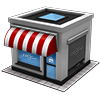III. Best Practices - Backing Up Checkout
The Database
Checkout builds on the open source PostgreSQL database server. The database directory is located at {Mac User ID}/Library/Application Support/Checkout/Database_93.checkout. If you are hosting multiple stores on this Mac, they will all exist in this one file. This directory also contains your license file and any custom reports that you might have. A typical Checkout database has a size of around 100 megabytes, depending on the amount of data in your store(s). You will normally never have to deal with the database directory itself. To make backups of your Checkout store, refer to the section about backing up below. Making a copy of the file Database.checkout does not result in a 100% reliable backup. Additionally, a backup created using the Store Administration interface will be a lot smaller.
Time Machine
Although Time Machine backups from the Checkout directory work most of the time, they are NOT 100% reliable and should not be used to reliably backup your Checkout store. When Checkout is running, Time Machine may fail to copy parts of the database that are currently in use and the resulting Time Machine backup of the database might be corrupt. It is advised to make regular backups as outlined in the section below. Backups created from the Store Administration interface themselves can be reliably backed up using Time Machine.
Backing up Stores
Checkout store backups are files with the extension .checkoutbackup and can be made through the Store Administration interface, available from the ‘Checkout’ menu, under ‘Manage Checkout Stores...’. Manage Checkout Stores is also available on the Welcome windows if your Mac is hosting a Checkout store. You are required to enter your Mac password before proceeding to the Store Administration window. After selecting the store to be backed up, select the Backup button and choose the name and location of your backup.
When you make a backup, the latest backup date will be stored in the database and can be reviewed from the Store Administration interface. Before emailing a backup to yourself for safe keeping, it is recommended to compress it to a zip archive. To create a zip archive, select the created .checkoutbackup file in the Finder and choose ‘Compress "
Restoring a Store
If you need to restore a store, first select Store Administration, available from the ‘Checkout’ menu, under ‘Manage Checkout Stores...’. You are required to enter your Mac password before proceeding to the Store Administration window. When you restore a store, all employee passwords will be reset with the password you choose. After you've restored the store and logged into it, you can assign each employee a unique password.
Please note that if you already have a store with the same name, it will not be replaced, but the restored store will be renamed.
Creating Additional Stores
If the Mac that you're running Checkout on is hosting a store, Create Store will no longer be available on the Welcome Window. You can create additional stores through Store Administration.
Technical Details
Checkout store backups are SQL database dump files created with the pg_dump utility. A .checkoutbackup file contains an entire store, including its employees and any imported custom templates, your store logo and preferences. Custom reports must be backed up manually. Because employee login credentials are dependent on how a Checkout store is loaded into the Checkout database, all employee passwords must be reset when a store backup is restored. Checkout uses a random 6-character database name when creating a store or loading a store backup into its database. This internally used database name is changed whenever a store backup is restored. As a consequence, you will need to reselect what store to connect to in the login window on all computers you use this store with after restoring from a backup.
Table of Contents
- Welcome to Checkout
- About this Manual
- The Welcome Screen
- Registering Checkout
- Set Up Your Store
- Managing Your Store
- Managing Your Store - General
- Managing Your Employees
- Managing Your Taxes
- Managing Your Suppliers
- Managing Your Products
- Managing Your Shipping
- Managing Your Templates
- Managing Your Shopify Web Store
- Managing Your Reports
- Managing Your Ledger
- Logging In
- Daily Usage - General
- Daily Usage - Managing Orders
- Daily Usage - Managing Invoices
- Daily Usage - Managing Customers
- Daily Usage - Till Count
- Daily Usage - Printing Labels
- Stock Room
